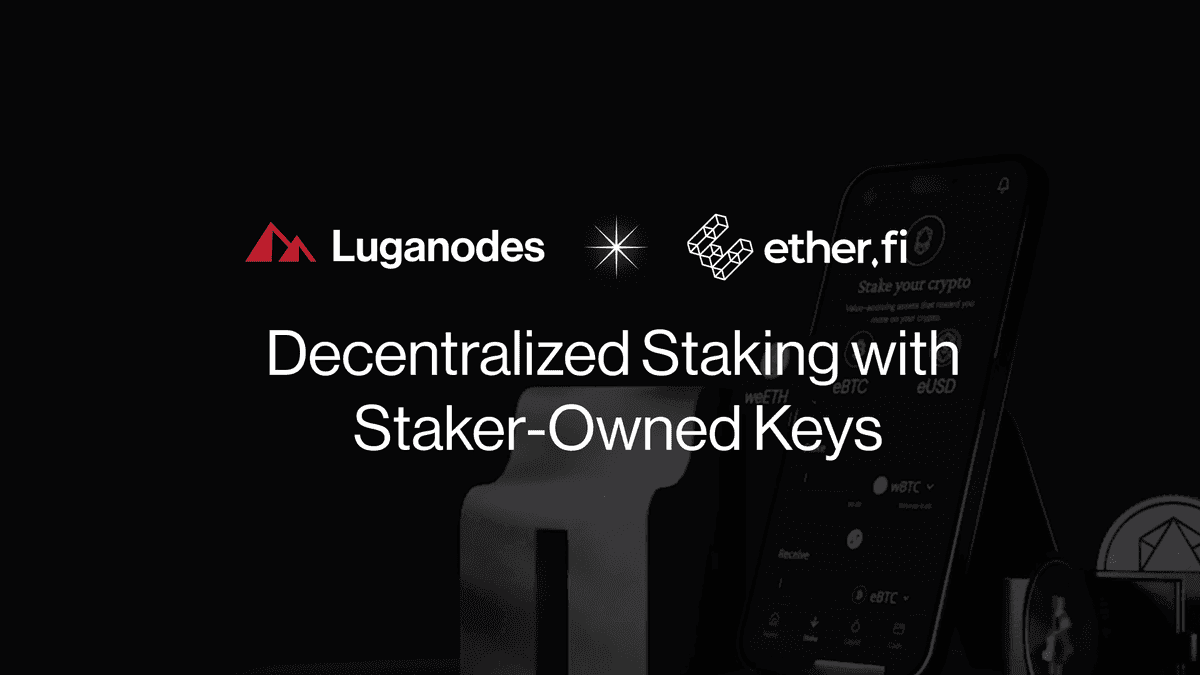4 min read
Luganodes x Ether.fi: Decentralized Staking with Staker-Owned Keys
Non-Custodial Staking, Reinvented

Introduction
As Ethereum continues its evolution, decentralized staking plays an increasingly critical role in securing the network while empowering participants. Luganodes is proud to support Ether.fi — a non-custodial, delegated staking protocol where stakers retain control of their validator keys and participate in a fully decentralized staking lifecycle.
By combining smart contract-based delegation, NFTs for validator ownership, and a liquid staking token (eETH), Ether.fi provides open staking infrastructure with built-in economic incentives and a sustainable path toward node service programmability.
The Ether.fi Model: Non-Custodial, Modular, and Sustainable
Ether.fi is designed for stakers of all sizes — from full 32 ETH delegators to eETH holders seeking liquid exposure. Its architecture ensures that stakers remain in control of their ETH and validator keys at every stage.
The protocol operates across three key phases:
Delegated Staking
Stakers deposit 32 ETH and are matched with node operators via an auction or trust mechanism. This launches a validator, with ownership represented by two NFTs:
-
T-NFT (30 ETH) — Transferable and yield-bearing
-
B-NFT (2 ETH) — Soulbound, higher-yield, with validator monitoring responsibility
The staker generates the validator key, encrypts it using the assigned node operator’s public key, and submits it on-chain.
The node operator launches and runs the validator, while the staker retains full control of both NFTs and can trigger an exit at any time.
The B-NFT also acts as a slashing deductible, incentivizing validator performance and uptime through aligned responsibility.
Liquidity Pool and eETH
Stakers with less than 32 ETH can participate through Ether.fi’s liquidity pool, receiving eETH — a rebasing liquid staking token backed by ETH and T-NFTs.
-
Depositors receive eETH and earn yield passively
-
eETH can be redeemed 1:1 for ETH (subject to pool liquidity)
-
If liquidity is low, validator exits are triggered to fulfill redemptions
Additionally, bond-holders who wish to earn higher yields can deposit ETH and join a queue to receive a B-NFT. Once enough ETH accumulates in the pool (to reach 32 ETH), a validator is launched:
-
The bond-holder generates the validator key and receives the B-NFT
-
The T-NFT is retained by the pool
-
A node operator runs the validator
-
The bond-holder is responsible for monitoring and triggering validator exits when needed
If they fail to do so, slashing penalties are applied — while exit notifications and tracking tools make monitoring easier.
Node Services Layer
Ether.fi is building a programmable infrastructure layer that allows validators (via NFTs) to enroll in additional services like EigenLayer.
Participation requires joint consent from:
-
The node operator
-
The B-NFT holder
-
The Ether.fi protocol
This design enables a broader validator economy, where infrastructure can be coordinated and monetized at scale using NFT metadata and protocol-level governance.
What Makes Ether.fi Unique
-
Non-custodial staking: Users control their validator keys throughout the staking lifecycle
-
NFT-based validator ownership: Transparent and flexible representation of stake and responsibilities
-
eETH liquidity: Earn staking yield while retaining liquid ETH exposure
-
Slashing-aware incentives: Yield is dynamically adjusted based on role and risk
-
Programmable infrastructure: Future-ready architecture for restaking and service extensions
Node Services and the Road Ahead
Ether.fi envisions a future where NFTs evolve from ownership primitives into programmable access points for staking infrastructure.
Validators can be enrolled into new services (such as EigenLayer) through a transparent consent system — enabling new reward models and restaking use cases.
The Ether.fi node client makes it easy for operators to launch, monitor, and register infrastructure — a critical step in making decentralized staking scalable and composable.
Luganodes x Ether.fi
As a leading validator, Luganodes proudly supports Ether.fi’s decentralized mission by operating secure, high-performance infrastructure that supports permissionless delegation and MEV-aware staking.
Our goal is to help strengthen Ether.fi’s validator set, deliver robust performance for eETH holders, and contribute to building a decentralized, programmable staking economy.
Conclusion
At Luganodes, we are committed to building the infrastructure Ethereum’s future demands. Ether.fi stands out for its emphasis on staker sovereignty, non-custodial control, and a sustainable approach to staking.
With validator key ownership, programmable NFTs, and a forward-looking node services layer, Ether.fi is redefining what it means to stake on Ethereum — and Luganodes is proud to help power that mission.
About Luganodes
Luganodes is a world-class, Swiss-operated, non-custodial blockchain infrastructure provider that has rapidly gained recognition in the industry for offering institutional-grade services. It was born out of the Lugano Plan B Program, an initiative driven by Tether and the City of Lugano. Luganodes maintains an exceptional 99.9% uptime with round-the-clock monitoring by SRE experts. With support for 45+ PoS networks, it ranks among the top validators on Polygon, Polkadot, Sui, and Tron. Luganodes prioritizes security and compliance, holding the distinction of being one of the first staking providers to adhere to all SOC 2 Type II, GDPR, and ISO 27001 standards as well as offering Chainproof insurance to institutional clients.
The information herein is for general informational purposes only and does not constitute legal, business, tax, professional, financial, or investment advice. No warranties are made regarding its accuracy, correctness, completeness, or reliability. Luganodes and its affiliates disclaim all liability for any losses or damages arising from reliance on this information. Luganodes is not obligated to update or amend any content. Use of this at your own risk. For any advice, please consult a qualified professional.